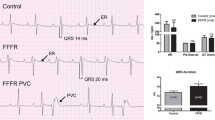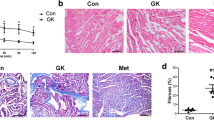Abstract
Amongst the complications of diabetes is arrhythmia, the risk of which depends on multiple factors. This study was designed to investigate several factors, including the effects of ATP-sensitive potassium current, lateralized connexins, and gap junction uncoupling. ATP-sensitive potassium channel (I KATP) opening is caused by ischemia, which can occur in diabetic or non-diabetic hearts. I KATP opening was simulated in this work to determine if the risk of ischemia-induced arrhythmias is affected by diabetes. Simulations were performed using healthy and diabetic models of rat and rabbit ventricle. Results showed that the diabetic rat model is less vulnerable to reentrant arrhythmia than the healthy rat model. The diabetic rabbit model was more vulnerable to reentrant arrhythmia than the healthy rabbit model. In both rabbit models, the vulnerability increased as the gap junctional coupling decreased. Opening of I KATP resulted in larger window of vulnerability. Conduction reserve was simulated based on 1D simulations for both rat and rabbit models. There was no difference between rat and rabbit conduction reserve. Our results showed that the simulation results are model-dependent, i.e., results from the rabbit model are similar to human clinical data, while the results from the rat model contradict human clinical observations, suggesting a significant species-dependence in arrhythmia vulnerability in the diabetic heart.










Similar content being viewed by others
References
Akar, F. G., D. D. Spragg, R. S. Tunin, D. A. Kass, and G. F. Tomaselli. Mechanisms underlying conduction slowing and arrhythmogenesis in nonischemic dilated cardiomyopathy. Circ. Res. 95:717–725, 2004.
Bulhak, A. A., C. Jung, C.-G. Ostenson, J. O. Lundberg, P.-O. Sjöquist, and J. Pernow. PPAR-alpha activation protects the type 2 diabetic myocardium against ischemia-reperfusion injury: involvement of the PI3-Kinase/Akt and NO pathway. Am. J. Physiol. Heart Circ. Physiol. 296:H719–H727, 2009.
Casis, O., M. Gallego, M. Iriarte, and J. A. Sánchez-Chapula. Effects of diabetic cardiomyopathy on regional electrophysiologic characteristics of rat ventricle. Diabetologia 43:101–109, 2000.
Choi, K. M., Y. Zhong, B. D. Hoit, I. L. Grupp, H. Hahn, K. W. Dilly, S. Guatimosim, W. J. Lederer, and M. A. Matlib. Defective intracellular Ca(2+) signaling contributes to cardiomyopathy in Type 1 diabetic rats. Am. J. Physiol. Heart Circ. Physiol. 283:H1398–H1408, 2002.
Chow, E., A. Bernjak, S. Williams, R. A. Fawdry, S. Hibbert, J. Freeman, P. J. Sheridan, and S. R. Heller. Risk of cardiac arrhythmias during hypoglycemia in patients with type 2 diabetes and cardiovascular risk. Diabetes 63:1738–1747, 2014.
Chu, L. M., R. M. Osipov, M. P. Robich, J. Feng, S. Oyamada, C. Bianchi, and F. W. Sellke. Is hyperglycemia bad for the heart during acute ischemia? J. Thorac. Cardiovasc. Surg. 140:1345–1352, 2010.
Clerc, L. Directional differences of impulse spread in trabecular muscle from mammalian heart. J. Physiol. 255:335–346, 1976.
De Vuyst, E., K. Boengler, G. Antoons, K. R. Sipido, R. Schulz, and L. Leybaert. Pharmacological modulation of connexin-formed channels in cardiac pathophysiology. Br. J. Pharmacol. 163:469–483, 2011.
Desrois, M., K. Clarke, C. Lan, C. Dalmasso, M. Cole, B. Portha, P. J. Cozzone, and M. Bernard. Upregulation of eNOS and unchanged energy metabolism in increased susceptibility of the aging type 2 diabetic GK rat heart to ischemic injury. Am. J. Physiol. Heart Circ. Physiol. 299:H1679–H1686, 2010.
Ebel, D., J. Müllenheim, J. Frässdorf, et al. Effect of acute hyperglycaemia and diabetes mellitus with and without short-term insulin treatment on myocardial ischaemic late preconditioning in the rabbit heart in vivo. Pflugers Arch. 446:175–182, 2003.
Erickson, J. R., L. Pereira, L. Wang, et al. Diabetic hyperglycaemia activates CaMKII and arrhythmias by O-linked glycosylation. Nature 502:372–376, 2013.
Fang, Z. Y., J. B. Prins, and T. H. Marwick. Diabetic cardiomyopathy: evidence, mechanisms, and therapeutic implications. Endocr. Rev. 25:543–567, 2004.
Ghaly, H. A., P. M. Boyle, E. J. Vigmond, Y. Shimoni, and A. Nygren. Simulations of reduced conduction reserve in the diabetic rat heart: response to uncoupling and reduced excitability. Ann. Biomed. Eng. 38:1415–1425, 2010.
Kanno, S., and J. E. Saffitz. The role of myocardial gap junctions in electrical conduction and arrhythmogenesis. Cardiovasc. Pathol. 10:169–177, 2001.
Katritsis, D. G., and A. J. Camm. Atrioventricular nodal reentrant tachycardia. Circulation 122:831–840, 2010.
Krames, B. B., and E. J. Van Liere. The heart weight and ventricular weights of normal adult albino rats. Anat. Rec. 156:461–464, 1966.
Kristiansen, S. B., B. Løfgren, N. B. Støttrup, D. Khatir, J. E. Nielsen-Kudsk, T. T. Nielsen, H. E. Bøtker, and A. Flyvbjerg. Ischaemic preconditioning does not protect the heart in obese and lean animal models of Type 2 diabetes. Diabetologia 47:1716–1721, 2004.
Lefer, D. J., R. Scalia, S. P. Jones, B. R. Sharp, M. R. Hoffmeyer, A. R. Farvid, M. F. Gibson, and A. M. Lefer. HMG-CoA reductase inhibition protects the diabetic myocardium from ischemia-reperfusion injury. FASEB J. 15:1454–1456, 2001.
Ma, G., M. Al-Shabrawey, J. A. Johnson, R. Datar, H. E. Tawfik, D. Guo, R. B. Caldwell, and R. W. Caldwell. Protection against myocardial ischemia/reperfusion injury by short-term diabetes: enhancement of VEGF formation, capillary density, and activation of cell survival signaling. Naunyn Schmiedebergs Arch. Pharmacol. 373:415–427, 2006.
Mahajan, A., Y. Shiferaw, D. Sato, et al. A rabbit ventricular action potential model replicating cardiac dynamics at rapid heart rates. Biophys. J. 94:392–410, 2008.
Marfella, R., M. D’Amico, C. Di Filippo, E. Piegari, F. Nappo, K. Esposito, L. Berrino, F. Rossi, and D. Giugliano. Myocardial infarction in diabetic rats: Role of hyperglycaemia on infarct size and early expression of hypoxia-inducible factor 1. Diabetologia 45:1172–1181, 2002.
Matsumoto, S., S. Cho, S. Tosaka, H. Ureshino, T. Maekawa, T. Hara, and K. Sumikawa. Pharmacological preconditioning in type 2 diabetic rat hearts: the roles of mitochondrial atp-sensitive potassium channels and the phosphatidylinositol 3-kinase-akt pathway. Cardiovasc. Drugs Ther. 23:263–270, 2009.
Noma, A. ATP-regulated K+ channels in cardiac muscle. Nature 305:147–148, 1983.
Nygren, A., M. L. Olson, K. Y. Chen, T. Emmett, G. Kargacin, and Y. Shimoni. Propagation of the cardiac impulse in the diabetic rat heart: reduced conduction reserve. J. Physiol. 580:543–560, 2007.
Pandit, S. V., R. B. Clark, W. R. Giles, and S. S. Demir. A mathematical model of action potential heterogeneity in adult rat left ventricular myocytes. Biophys. J. 81:3029–3051, 2001.
Pandit, S. V., W. R. Giles, and S. S. Demir. A mathematical model of the electrophysiological alterations in rat ventricular myocytes in type-I diabetes. Biophys. J. 84:832–841, 2003.
Pierce, G. N., and J. C. Russell. Regulation of intracellular Ca2+ in the heart during diabetes. Cardiovasc. Res. 34:41–47, 1997.
Ravingerova, T., R. Stetka, and D. Pancza. Susceptibility to ischemia-induced arrhythmias and the effect of preconditioning in the diabetic rat heart. Physiol. Res. 49:607–616, 2000.
Ravingerova, T., J. Neckar, F. Kolar, R. Stetka, K. Volkovova, A. Ziegelhöffer, and J. Styk. Ventricular arrhythmias following coronary artery occlusion in rats: is the diabetic heart less or more sensitive to ischaemia? Basic Res. Cardiol. 96:160–168, 2001.
Ravingerová, T., A. Adameová, J. Matejíková, T. Kelly, M. Nemčeková, J. Kucharská, O. Pecháňová, and A. Lazou. Subcellular mechanisms of adaptation in the diabetic myocardium: relevance to ischemic preconditioning in the nondiseased heart. Exp. Clin. Cardiol. 15:68–76, 2010.
Sasyniuk, B. I. Concept of reentry versus automaticity. Am. J. Cardiol. 54:A1–A6, 1984.
Seidel, T., A. Salameh, and S. Dhein. A simulation study of cellular hypertrophy and connexin lateralization in cardiac tissue. Biophys. J. 99:2821–2830, 2010.
Shaw, R. M., and Y. Rudy. Electrophysiologic effects of acute myocardial ischemia: a theoretical study of altered cell excitability and action potential duration. Cardiovasc. Res. 35:256–272, 1997.
Shimoni, Y., L. Firek, D. Severson, and W. Giles. Short-term diabetes alters K+ currents in rat ventricular myocytes. Circ. Res. 74:620–628, 1994.
Smeets, J. L., M. A. Allessie, W. J. Lammers, F. I. Bonke, and J. Hollen. The wavelength of the cardiac impulse and reentrant arrhythmias in isolated rabbit atrium. The role of heart rate, autonomic transmitters, temperature, and potassium. Circ. Res. 58:96–108, 1986.
Su, H., X. Sun, H. Ma, et al. Acute hyperglycemia exacerbates myocardial ischemia/reperfusion injury and blunts cardioprotective effect of GIK. Am. J. Physiol. Endocrinol. Metab. 293:E629–E635, 2007.
Tsang, A., D. J. Hausenloy, M. M. Mocanu, R. D. Carr, and D. M. Yellon. Preconditioning the diabetic heart: the importance of Akt phosphorylation. Diabetes 54:2360–2364, 2005.
Varró, A., D. A. Lathrop, S. B. Hester, P. P. Nánási, and J. G. Papp. Ionic currents and action potentials in rabbit, rat, and guinea pig ventricular myocytes. Basic Res. Cardiol. 88:93–102, 1993.
Vigmond, E. J., M. Hughes, G. Plank, and L. J. Leon. Computational tools for modeling electrical activity in cardiac tissue. J. Electrocardiol. 36:69–74, 2003.
Whittington, H. J., G. G. Babu, M. M. Mocanu, D. M. Yellon, and D. J. Hausenloy. The diabetic heart: too sweet for its own good? Cardiol. Res. Pract. 2012. doi:10.1155/2012/845698.
Wiegerinck, R. F., A. O. Verkerk, C. N. Belterman, T. A. B. Van Veen, A. Baartscheer, T. Opthof, R. Wilders, J. M. T. De Bakker, and R. Coronel. Larger cell size in rabbits with heart failure increases myocardial conduction velocity and QRS duration. Circulation 113:806–813, 2006.
Winfree, A. T. Electrical turbulence in three-dimensional heart muscle. Science 266:1003–1006, 1994.
Xie, Y., D. Sato, A. Garfinkel, Z. Qu, and J. N. Weiss. So little source, so much sink: requirements for afterdepolarizations to propagate in tissue. Biophys. J. 99:1408–1415, 2010.
Zeevi-Levin, N., Y. D. Barac, Y. Reisner, I. Reiter, G. Yaniv, G. Meiry, Z. Abbasi, S. Kostin, J. Schaper, M. R. Rosen, N. Resnick, and O. Binah. Gap junctional remodeling by hypoxia in cultured neonatal rat ventricular myocytes. Cardiovasc. Res. 66:64–73, 2005.
Zhang, Y., J. Xiao, H. Lin, X. Luo, and H. Wang. Ionic mechanisms underlying abnormal QT prolongation and the associated arrhythmias in diabetic rabbits: a role of rapid delayed rectifier K + current. Cell Physiol. 2007. doi:10.1159/000100642.
Acknowledgments
This research was supported by Natural Sciences and Engineering Research Council of Canada (NSERC). Funding was provided by Canadian Network for Research and Innovation in Machining Technology, Natural Sciences and Engineering Research Council of Canada.
Conflict of interest
To the best of our knowledge, no conflict of interest, financial or other, exists.
Statement of human and animal studies
The study did not include human or animal experiments.
Author information
Authors and Affiliations
Corresponding author
Additional information
Associate Editors Robert L. Abraham and Ajit P. Yoganathan oversaw the review of this article.
Rights and permissions
About this article
Cite this article
Ghazanfari, A., Vigmond, E. & Nygren, A. Arrhythmia Vulnerability in Diabetic Cardiac Tissue is Species-Dependent: Effects of I KATP, Uncoupling, and Connexin Lateralization. Cardiovasc Eng Tech 8, 527–538 (2017). https://doi.org/10.1007/s13239-017-0315-0
Received:
Accepted:
Published:
Issue Date:
DOI: https://doi.org/10.1007/s13239-017-0315-0




